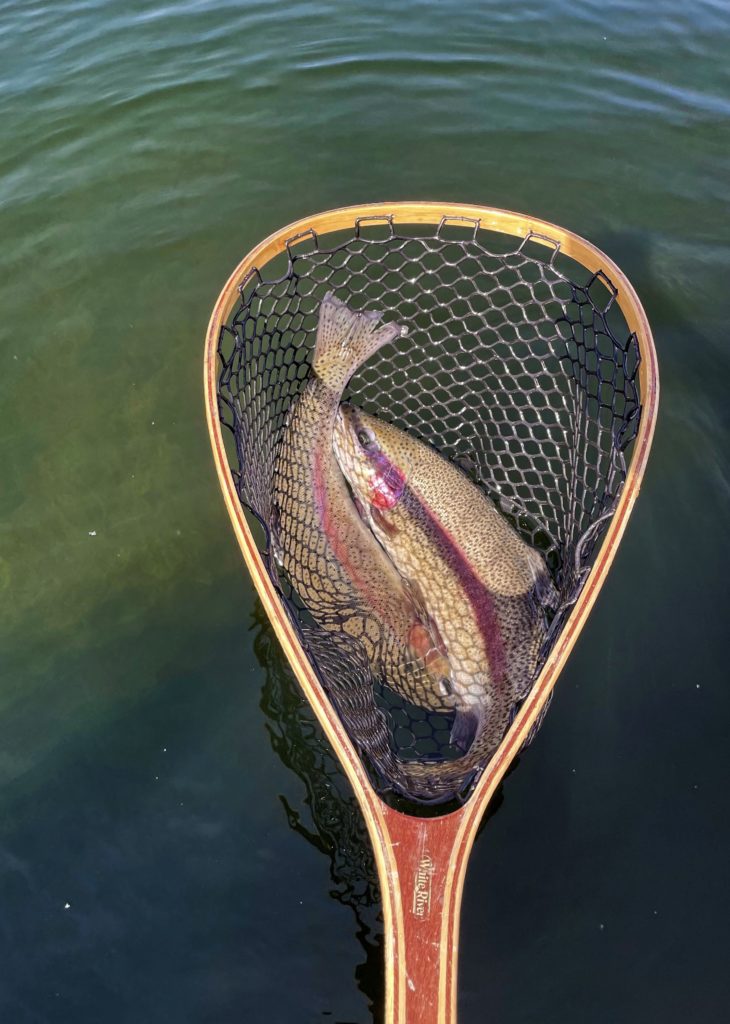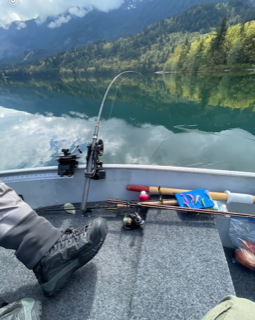OUTLOOK
We have a big report for everyone this week! First off, if you have been outside at all this week you will know the weather continues to be cool with rain this weekend and a warming trend at the back end of next week. As we’ve noted before, the cooler weather is actually great for fishing. There are a ton of options right now if you are looking to get out.
In this week’s report, we have some fun sturgeon fishing info. from Ethan who has been hitting the Lower Fraser bank fishery and it has been excellent. He goes over everything you need to know from tackle to eulachan rigging. Check it out If you want to try this very easy and cool fishery.
We also have a piece on how to fish lakes that are not your classic shallow interior style lakes. These lakes are the ones that are super deep and thus, are often hard to fish. If you live near one of these coastal style lakes there is hope. Taylor goes over the gear you need and the general strategies. It is quite different from classic shallow lake strategies but, with some determination, they can pay off big if you get them dialed in.
Though the above fisheries are great niche options, Interior lake fishing reports continue to stream in. It has been good and we are hearing ice off reports from as far north as Williams Lake. Sterling goes over everything we have heard, plus, he has some cool observations from his outings last week.
For Lower Mainland river anglers, we have a report this week on the Chilliwack from Gavin where he covers what you can expect heading into May on the river. Matt talks a little about the Squamish and Harrison in the video report.
On the saltwater fishing front, bottom fishing has been good since it opened across the strait last Sunday. The marine forecast has made the crossing a little challenging some days but it has been worth the trip if you can get across. We will be back next week with a full saltwater report. Note the commercial prawn fishery opened yesterday so that will make the prawning a little more challenging.
Last, but not least, Matt is here this week with a video version of the report – Click below for that and if you want a short fun sturgeon video check the link below the Video Report.
For those who are interested in the Video about fishing Sturgeon in the Lower Fraser River click on the link below:
CLASSES AND COURSES
Introduction To Fly Fishing
This course was specifically designed to give the new fly fisher the basic knowledge, casting skills and fly fishing strategies to effectively fish our local BC waters. This course is comprised of two sessions; 3hr evening seminar and a 3hr casting session. The dates below show the seminar date first and casting date second.
Dates: (May 10 & 14), (Jun 15 & 18), (July 12 & 17), (Sept 20 & 24) All dates are 2022 dates.
Cost: $150.00
Zoom Seminar Time: 6:30pm – 9:30pm
Casting Time(s): 10am – 1pm or 1:30pm -4:30pm
TYING BEACH FLY PATTERNS
Join Pacific Angler for a 3hr evening seminar of tying flies specific to catching salmon on our coastal beaches. Without a doubt, fly selection is critical while beach fishing.
These flies are often not commercially available, so successful beach anglers learn to tie their own patterns. Your instructor will walk you through each fly pattern step-by-step.
This Tying Beach Fly Patterns course is suitable for fly tiers with a basic knowledge. Students are required to supply their own vise, tools and materials. A 10% discount is available on fly tying materials and tools purchased for the course.
Date: May 18, 2022
Cost: $50.00+GST
Time: 6:30pm – 9:30pm
FRESHWATER FISHING REPORTS
Chilliwack/Vedder River Fishing Report
We are nearing the end of the steelhead season on the C/V, and most local gear anglers have packed up their rods for the season. Looking back at the season, it truly has been a unique one. Given the conditions, some anglers had excellent success while others who normally do, didn’t. Numbers of steelhead were strong this season and the river changed into a completely different beast. It will be interesting to play and explore during the upcoming salmon season with all the different runs and guts that formed with the floods.
For those who wish to fish for the next little bit, keep in mind the regulations changes listed in our diagram:
Referencing the regulation diagram we put together, you will notice that strictly the lower river is open, which makes for great water to swing flies in. Historically, anglers do run into fresh steelhead well into May but the numbers are not crazy. Spend some time swinging and you may be surprised. With warmer temperatures and brighter days, opting for a lighter MOW tip and brighter fly is not a bad option, T-8 and pink/white flies are my go-tos this time of year. Note that there is a chance of running into kelts moving back downriver after spawning; these kelts are generally hyper aggressive to gain much needed nutrition as fast as possible. Please handle these fish with care so they can come back as large repeat spawners!
Tight Lines,
Gavin Lau
Shore Fishing for Lower Fraser Sturgeon
The spring sturgeon fishery on the Fraser River has been exceptionally good the past few weeks. Shore fishing for dinos can be a very enjoyable fishery especially when access to a boat isn’t in the cards.
The spring freshet seems to be holding off due to the unseasonably cold weather. Nonetheless, as of writing, this the river is rising slightly so we seem to be on the brink of the freshet at the moment.
Historically, the Fraser eulachon run hits its peak within the month of April and then slowly tapers off into May and June. Eulachon are small baitfish that come into the Fraser River to spawn each year. Typically, they spawn in the lower reaches of the Fraser and, like salmon after they spawn, they die. Eulachons then give sturgeon a main food source after a scarce winter.
The problem with eulachons is they tend to be soft and fall apart. This makes them difficult to run as bait. There are a few different ways to rig eulachons. My preferred way to rig them is using a half hitch with your leader to secure them. 1-3 half hitches depending on how much of the eulachon you decide to use will secure it fairly well. I like to try and conceal the hook slightly then a half hitch using your leader. When you hook a fish the half hitch will then simply pull loose.
Gear is fairly simple when targeting sturgeon from shore. Typically, for most shore sturgeon fishing opportunities, a longer rod is recommended to increase casting distance. Rods in the 8–12′ range are ideal with the upper end of that window being ideal for adding distance to your cast. Spinning reels 6000s size and up and conventional reels size 30 and up ideally with a lever drag are both great options for chasing dinos. The biggest thing with reels is line capacity. Unlike sturgeon fishing on a boat, you can’t pull anchor and chase them so having a large amount of line capacity can be extremely beneficial. Another shore fishing must have is a rod holder. Rod holders keep your rod steady and allow you to easily watch the tip for what often are very small and subtle bites. The new Shorelord rod holders we have in the shop have proven to be excellent as I’ve had trouble finding a rod holder suitable for a heavy rod and reel setup.
As shown in the photo the terminal tackle setup is fairly simple. Everyone has their opinion as far as hooks go. 7/0-10/0 Circle and J hooks are both great options. A few of my favourites being Gamakatsu Big River Bait hooks, Gamakatsu Circle hooks and Owner Cutting Points. As for leader, I strictly use Tuf Line sturgeon leader. It is a braided nylon and it is extremely abrasion resistant as well as fairly thick which helps to not cut up the fish if it rolls while fighting. 130lb test mainline and up is what is recommended as the minimum strength line. Check out the Guidelines for Angling White Sturgeon in BC here:
10oz-22oz wedge weights is the typical weight range. Keeping a wide variety of weights is beneficial at this time of the year, tides, and current can dictate how much lead you need to stick to the bottom and fish effectively. Size 1-2/0 barrel swivels and snap swivels work excellent. The snap swivel connects your weight and also acts as a slider. The beads separate your weight and your leader which help protect your knot as well as mitigate tangles.
As always, if you have any questions, be sure to stop by the shop. I’m always eager to talk about sturgeon fishing.
Ethan Da Silva
STILLWATER FISHING REPORTS
Interior Lake Fishing Report
Ice off conditions are still holding out on a couple lakes north of 1100m but everything is very close at this point. We need a string of 15+ degree days followed by heavy wind to get every lake ice free. It’s definitely worth getting out there as the fishing is really picking up on the lakes that have been off for a month now.
I got a chance to get out last weekend and got into some consistent 10AM-3PM chironomid hatches that produced solid fish. I’ve been hearing a lot of similar reports on lakes in the Kamloops/Merritt area that have gone through turnover and are above that 50 degree Fahrenheit threshold for consistent chironomid hatches. We’ll really see a big jump in chironomid hatches once we finally get through this wet and cold spell. Next week’s weather looks great with dry 20 degree weather in Kamloops and 12+ degree days in the Cariboo.
Early May is often a very confusing time for people to fish as they’re unsure if lakes are in pre-turnover, turnover, or post turnover so they approach a lake hesitantly unsure of what to start with. It’s part of the reason why I always encourage people to visit the same lake year after year to really learn the nuances.
I’ve got a few general tips that I’ve noticed on the lakes I’ve visited. You’ll notice that fishing right after ice off is slow for the first 2-3 days followed by incredible fishing for 5-7 days in shallower water (6-12 feet) prior to turnover. I fish a ton of leeches and scuds during this period as fish will be eager to feed on anything buggy as their metabolism will get a kickstart with the subtle jump in water temperature. I’ve always found hot headed beads (orange/chartreuse/red) on my leeches work better during this period than any other season.
After this short pre-turnover period, the lake undergoes turnover and fish go off the bite. There’s not really anything you can do during this period. I wrote a bit about turnover on April 22nd so look back in that article to find a bit of extra information.
After turnover, the fish go back on the bite. There’s usually a short 7-10 day window where you’ll only see size 20-22 chironomids, which are typically lime or green. I don’t even try and mimic these patterns and still stick to my leeches and scuds but will start to incorporate damsel imitations like Brian’s Marabou Wigglers (BMWs), straggle string patterns, such as vampire leeches, or pink and sunburst blobs into my repertoire. Fish these patterns anywhere from 8-16 feet of water on either a full floating line, hover, type I intermediate, or a type III sinking line depending on depth. All These lines and patterns will at least put you into a couple fish, which you can then throat pump to get a better gauge of what’s happening.
A really cool line to check out is the Scientific Angler Sonar Seamless Density I/III line. It’s got an intermediate (1.25 inch per second) running line with a sink 3 head and two hang markers at 10 and 20 ft so you’re aware of how far out you still are. If you pump chironomids, break out the full floating line and hold on because the fish won’t be far behind.
Jason wrote a great piece in last week’s report about how he uses his depth sounder to find the fish and get dialed in on feeding fish. It’s important to constantly be moving if you’re not finding fish and a hatch is happening. I tend to set a 10-15 minute limit on my spot if I’m getting no action. Your standard ASB wrapped chironomids should always produce a couple bites for you so not getting anything is probably a sign that you’re in the wrong spot or your leader setup is off. Chironomid leaders are far from simple so come by the shop and one of us will show you how we set up our leaders. If your leader and fly selection is great, then it’s definitely a sign that you need to move. A confident fisherman will always catch more fish than the unconfident one and that’s a result from knowing that a confident fisherman will continue to move when he knows he has the right formula.
Sterling Balzer
How to Fish Our Big Deep Coastal Lakes …It’s Hard but Rewarding!
Interior lake season is well underway, and Instagram is getting flooded with pictures of huge rainbows, stomach pump samples and custom-tied chironomids. Interior lakes truly offer some of the best fishing that BC has to offer, but some of us don’t have the time, means, or determination to drive a couple hours and spend a few days up-country… so what do we do? Well, there are a bunch of lakes in the Lower Mainland that offer good fishing for trout and char, albeit with a completely different approach… and I’m not talking about the local stocked lakes.
Unlike the interior lakes, our big coastal lakes are not rich in bug life- so the fish in them are usually predatory, feeding mainly on other fish. As such, hanging a tiny chironomid under an indicator is usually a laughable concept. With the coastal lakes usually being quite large, fish in them tend to being quite scattered. The most efficient way to target them is by trolling, ideally with a downrigger- much like you would target salmon in saltwater. The concept remains the same, but everything is downsized- smaller lures, smaller downriggers, lighter gear… you get the idea.
A 12’ aluminum boat is fine most of the time, but some of the bigger local lakes tend to get alarmingly windy, so a larger boat isn’t a terrible idea- I alternate between a 12’ tin-can and an 18’ fiberglass, depending on what lake I’m heading to.
Lakes such as Chilliwack, Alouette, Chehalis and Harrison are all home to decent populations of cutthroat trout, rainbow trout and bulltrout, some of which may exceed 10lbs on occasion. The fishing is usually not incredibly productive, but a good day will usually involve getting a couple fish to the boat- this is a quality, not a quantity fishery.
The setup is fairly simple and should be pretty familiar if you’ve ever trolled for salmon. Rods should be light and sensitive enough to detect bites from smaller fish, but strong enough to handle the strain of trolling with a downrigger… or a big, angry bulltrout. There are a lot of Kokanee trolling rods on the market that fit this bill perfectly, like the Daiwa North Coast Kokanee rod or the Okuma Kokanee Black. I use a Kokanee Black and am very happy with it. Level wind reels are a common choice, since they’re easy to use and offer adjustable drags and high gear ratios, but there has been a recent trend of anglers using heavy-duty fly reels spooled with mono as pseudo “mini-mooching reels”. For those of you who are used to using 1:1 mooching reels, this may be a more enjoyable option; I personally use a Reding Grande 7/8/9 spooled with 15lb mono and I really like it.
Smaller dodgers such as Gibbs Dogtails are always a good option, and lure choice is usually dictated by what you’re targeting- I usually have an assortment of Apexes, Brad’s mini cut-plugs, Skinny-G spoons and Lyman plugs for larger predatory fish, and some wedding bands, wiggle hoochies and Mini-G spoons for smaller Trout. Any downrigger will work, but bigger is always better… if your boat is set up to use electric downriggers, you might as well use ‘em.
A good fish finder is also incredibly useful as well, and can make the difference between finding fish and getting skunked; make sure to read Jay’s excellent lake sounder synopsis if you missed it in last weeks report.
One of the issues with bigger lakes is their size- they’re big, so the fish are usually spread out, and they can be anywhere. As such, it’s usually a good idea to focus your attention on areas that might draw fish in- areas such as creek mouths, drop-offs and sunken debris can all concentrate fish, but be mindful of snags. The biggest benefit to trolling is that you can cover tons of water, so you can thoroughly fish an area in a minimal amount of time. If the fish aren’t cooperating, just move on to another area.
I find that the big lakes are usually fairly quiet in terms of angling pressure- they’re not the most productive fisheries, and they can be quite “moody” and technical at times, so a lot of people don’t bother. But, if you’re looking for a different fishery that has the potential to produce some big fish, consider giving the big local lakes a shot.
Taylor Nakatani













